|
|
|||||||||||||||||||||||||||||||||||
|
["The Water-babies: A fairy tale for a Land-baby"] ["Green Willow and other Japanese Fairy Tales"] ["Stories from the Pentamerone"] ["The Complete Poetical Works of Geoffrey Chaucer"] ["Folk Tales of Bengal"] ["The Fairy Book"] ["The Book of Fairy Poetry"]
|
|||||||||||||||||||||||||||||||||||
|
[Up]
[Home] |
|
||||||||||||||||||||||||||||||||||
|
|||||||||||||||||||||||||||||||||||
|
|
|||||||||||||||||||||||||||||||||||
Our Greeting Cards and Fine Art Posters showing the artworkof Warwick Goble from "Indian Myth and Legend" (1913)
|
|||||||||||||||||||||||||||||||||||
|
|||||||||||||||||||||||||||||||||||
|
|||||||||||||||||||||||||||||||||||
Warwick Goble - the colour illustrations for "Indian Myth and Legend" (1913)
|
|||||||||||||||||||||||||||||||||||
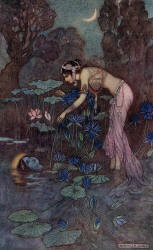 |
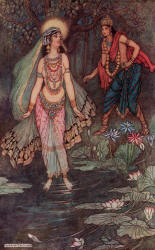 |
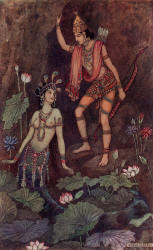 |
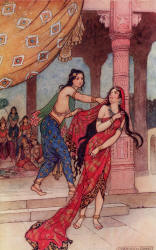 |
||||||||||||||||||||||||||||||||
|
Frontispiece
Sita finds Rama among the Lotus blooms
|
Prelude to the Great Baharata War
Shantanu meets the Goddess Ganga
|
Triumph of the Pandavas
Arjuna and the River Nymph |
The Great Gambling Match
The Ordeal of Queen Draupadi |
||||||||||||||||||||||||||||||||
|
Fine Art Poster (10x18'')
Code: WG IML C1 10x18
|
Fine Art Poster (10x18'')
Code: WG IML C2 10x18
|
Fine Art Poster (10x18'')
Code: WG IML C3 10x18
|
Fine Art Poster (10x18'')
Code: WG IML C4 10x18
|
||||||||||||||||||||||||||||||||
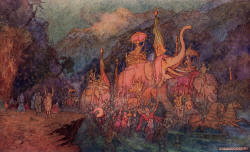 |
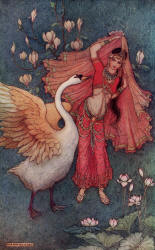 |
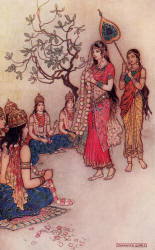 |
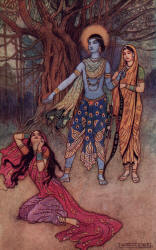 |
||||||||||||||||||||||||||||||||
|
Atonement and the Ascent to Heaven
The Return of the Heroes slain in Battle |
Nala and Damayanti
Damayanti and the Swan
|
Nala and Damayanti
Damayanti choosing a Husband |
The Rape of Sita
Rama spurns the Demon Lover
|
||||||||||||||||||||||||||||||||
|
Fine Art Poster (14x11'')
Code: WG IML C5 14x11
|
Fine Art Poster (10x18'')
Code: WG IML C6 10x18
|
Fine Art Poster (10x18'')
Code: WG IML C7 10x18
|
Fine Art Poster (10x18'')
Code: WG IML C8 10x18
|
||||||||||||||||||||||||||||||||
|
Mackenzie's Introduction to "Indian Myth and Legend"
This volume deals with the myths and legends of India, which survive to us in the rich and abundant storehouse of Sanskrit literature, and with the rise and growth of Brahmanism, Buddhism, Jainism and other religions. The reader is introduced to the various sacred works of the Hindus, including the ancient invocatory hymns of the four Vedas, the later speculative and expository "Forest Books" in which "the Absolute is grasped and proclaimed", and those great epic poems the "Rąmąyana", which is three times longer than the "Iliad", and the "Mąhąbharanta", which is four times longer than the "Rąmąyana". In no other country have the national poets given fuller and finer expression tot he beliefs and ideals and traditions of a people, or achieved as a result wider and more enduring fame. At the present day over two hundred million Hindus are familiar in varying degrees with the legendary themes and traditional beliefs which the ancient forest sages and poets of India invested with much beautiful symbolism, and used as mediums for speculative thought and profound spiritual teachings. The sacred books of India are to the Hindus what the Bible is to Christians. Those who read them, or hear them read, are believed to be assured of prosperity in this world and of salvation in the next. To students of history, of ethnology, and of comparative religion they present features of peculiar interest, for they contain an elaborate sociology of the ancient Aryo-Indians, their political organizations, their codes of laws, their high ethical code, and above all their conceptions of God, the soul, and the Universe. Some knowledge of them is necessary for those who desire to approach with sympathy the investigation of the religious beliefs of our Hindu fellow men and to understand their outlook upon life and the world.
The Introduction deals with various aspects of the study of these ancient myths and legends which have been the inspiration of a national literature infused with much grandeur and sublimity. The historic Aryan controversy, of which the science of comparative mythology is a by-product, is passed under review, and it is shown to what extent philological theories regarding race problems have been modified during recent years as a result of the adoption of broader and more exact methods of ethnic and archęological research and the ever-extending study of comparative mythology. There has also been condensed much important data dealing with the early phases of Aryo-Indian civilization accumulated for historical purposes by industrious and painstaking Sanskrit scholars who have been engaged in investigating and systematizing the internal evidence of the various religious poems and treatises. It will be found that no general agreement has yet been reached regarding Aryo-Indian chronology, but it now appears to be well established that although there were early cultural as well as racial "drifts", fresh invasions, which had far-reaching results in the social and religious life of northern India, occurred at a late period in what is known as the Vedic Age. In consequence, the problem presented by this ancient civilization tends rather to grow more complex than to become simplified. Its origin is still wrapped in obscurity. At the very dawn of history Aryo-Indian culture had attained a comparatively high state of development, and a considerable period must be allowed for its growth. Even some of the ancient Vedic hymns, addressed by priests to the deities, are styled "new songs", which suggests the existence of an older collection. Many of them also afford indications that immemorial beliefs were in process of change and fusion. The sublime deities, Varuna and Mitra (Mithra), for instance, were already declining in splendour. Yet they must have been closely associated with Indra, king of the gods, in the unknown Aryan homeland, as is made evident by and inscription recently deciphered at Boghaz Köi, in Asia Minor, which refers to them as deities of the mysterious Mitanni people who were of Aryan speech like the settlers in the Punjab. There is no evidence, however, that the Mitanni rulers gave recognition to the fire god Agni, who in India was exalted as the twin brother of Indra. The problem involved may not be devoid of ethnic significance, although the identity of the Agni-worshipping section of the early raiders remains obscure.
During the early Vedic Age in India prominence was given to the gods: the social organization was of patriarchal character; the goddesses remained shadowy and vague, some being, indeed, little more than figures of speech. A great change took place, however, after the invasions of the Bharata and other tribes who are now referred to as "late comers". Profound and speculative thinkers attained to the pantheistic conception of the world soul; new doctrines, which are not referred to in the Vedic hymns, regarding the ages of the universe and transmigration of souls, received wide acceptance as the result of missionary efforts: the Vedic gods were reduced to the position of minor deities and new goddesses rose into prominence, one indeed being Bharati, throw much light on the significance of the immemorial practice. White and black horses were alternately favoured, and it is evident that the practice was not only associated with solar worship, but was also intended to secure fertility - crops, and therefore rain in the first place, increase of flocks, hers, human offspring and the like - as is undoubtedly the case among the modern-day Buriats. In India the horse was also offered up as a sin offering, a late conception, evidently. A prominent feature of this sacrifice in most countries was the decapitation of the sacrificial victim. Recent evidence from Egypt suggests that the sacrifice of the ass may have preceded the sacrifice of the horse. Professor Flinders Petrie has found in a triple tomb in the early dynastic Tarkhan cemetery the skeletons of three asses with the heads cut off and placed beside them. He suggests that the animals were killed to accompany their owner to the other world. The Buriats still sacrifice horses at graves, professedly for the same reason. As this custom was not prevalent throughout Ancient Egypt, it may have been an importation, connected, perhaps, with the myth about the sun-ass which gallops round a hill-surrounded world followed by the pursuing night serpent. An isolated reference is also made to the sacrifice of the ass in a Twelfth Dynasty story about a Naga-like demigod, a fact which emphasizes the historical importance of the material embedded in folk tales and mythologies. In this connection it may be noted that certain developed myths suggest there may have been either a cultural contact of Ancient Egypt with India, through an unidentified medium, or an infusion of religious ideas into both countries from a common source. In an Indian creation myth Prajįpati weeps creative tears like the Egyptian sun-god Ra, whose rays are tears from which all things spring, as Maspero shows.
In India the juice of the soma plant was identified with the vital principle, and the demons were the poisoners of crops and plants; in Egypt honey-flowers and sacred trees sprang from the fertilizing tears of deities, while the tears of demons produced poisonous plants, diseases and the like. Like the Egyptian Horus, the Indian Prajįpati, or Bahma, sprang from a lotus bloom floating on the primordial waters. The chaos-egg myth is also common to both mythological systems. Brahma issues from a golden egg like Ra, and a similar myth is connected with the Egyptian Ptah and Khnumu, and with the Chinese P'an Ku, while the egg figures in Eur-Asian folk tales which contain the germs of the various mythologies. All mythologies have animistic bases; they were, to being with, systematized folk beliefs which were carried hither and thither in various stages of development by migrating and trading peoples. Each separate system bears undoubted traces of racial or local influences; each reflects the civilization in which it flourished, the habits of thought and habits of life of the people, and the religious, ethical, and political ideals of their rulers and teachers. When well-developed myths of similar character are found in widely separated districts, an ethnic or cultural contact is suggested. Such myths may be regarded as evidence of remote racial movements, which, although unsupported by record or tradition, are also indicated by ethnological data. It is hoped that the reader will find much suggestive material in this connection in their study of the myths and legends of India. They will also find that many of the tales retold in this volume have qualities which make universal appeals, and that some are among the most beautiful which survive from the civilizations of the ancient world.
Not a few, we are assured, will follow with interest, the development from primitive myths of great and ennobling ideas which have exercised a culturing influence in India through many long centuries, and as still potent factors in the domestic, social, and religious life of many millions of Hindus.
|
|||||||||||||||||||||||||||||||||||
|
[Home] [Medieval and Renaissance Collection] [Golden Age of Illustration Collection] [Myths] [Fables] [Fairies] [Fairy Tales] [Blog] [About Us] [Special Offer]
Send mail to
ThePeople@SpiritoftheAges.com
with questions or comments about this web site.
|
|||||||||||||||||||||||||||||||||||
.jpg)
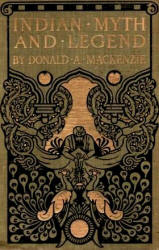
.jpg)
%20(sample)%20(250).jpg)
%20(sample)%20(rear)%20(250).jpg)
%20(sample)%20(300).jpg)